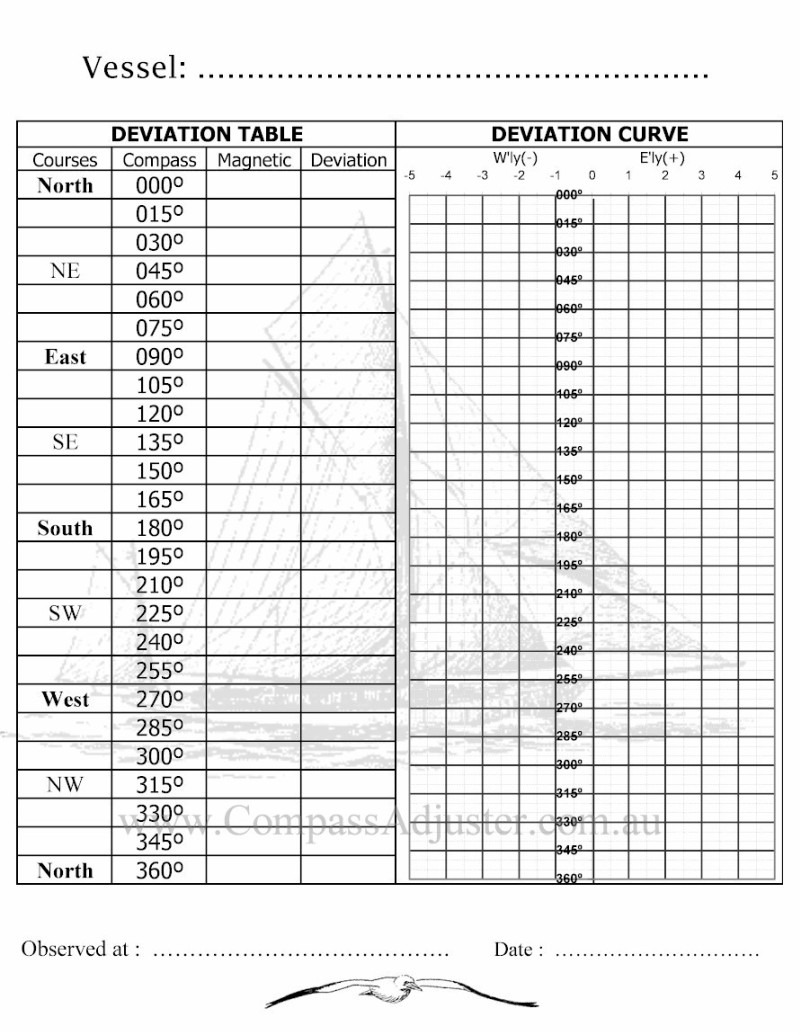A Compass Deviation Card Template is a navigational tool used to visualize and record the magnetic compass errors caused by nearby ferrous materials, such as the ship’s hull or equipment. These errors, known as compass deviations, can significantly affect the accuracy of navigation, leading to potential hazards if not properly accounted for. A well-designed Compass Deviation Card Template is essential for ensuring safe and efficient navigation.
Essential Components of a Compass Deviation Card Template

1. Heading: The heading should clearly indicate the purpose of the template, such as “Compass Deviation Card” or “Deviation Table.” It should be prominently displayed at the top of the template.
2. Ship Information: This section should include essential details about the vessel, including its name, IMO number, and call sign. This information helps identify the specific deviation card and ensures its relevance to the vessel.
3. Date of Deviation: The date when the deviations were measured should be clearly stated. This is crucial for tracking changes in the vessel’s magnetic environment over time.
4. Deviation Table: The core of the template is the deviation table, which presents the compass deviations for various headings. The table should be organized in a clear and concise manner, with headings listed in a systematic order (e.g., North, Northeast, East, Southeast, etc.). The deviations should be recorded in degrees and minutes, using a standardized format.
5. Notes Section: A designated area for notes should be provided. This section can be used to record any additional observations or comments related to the deviations, such as unusual magnetic disturbances or changes in the vessel’s equipment.
Design Considerations for a Professional Compass Deviation Card Template
1. Clarity and Readability: The template should be designed to be easily read and understood by anyone familiar with navigation. Use clear fonts and a consistent layout to enhance readability.
2. Organization: The information should be presented in a logical and organized manner, with a clear separation between different sections. This helps users quickly locate the information they need.
3. Professional Appearance: A professional appearance is essential for building trust and credibility. Choose a clean and modern design that reflects the seriousness of navigation.
4. Durability: The template should be printed on high-quality paper or laminated to ensure its durability. This is especially important for marine environments where the template may be exposed to harsh conditions.
5. Customization: Consider providing options for customization, such as different heading intervals or additional data fields. This allows users to tailor the template to their specific needs.
Example of a Professional Compass Deviation Card Template
Heading: Compass Deviation Card
Ship Information:
Date of Deviation: [Date]
Deviation Table:
| Heading | Deviation |
|—|—|
| N | [Deviation] |
| NNE | [Deviation] |
| NE | [Deviation] |
| ENE | [Deviation] |
| E | [Deviation] |
| ESE | [Deviation] |
| SE | [Deviation] |
| SSE | [Deviation] |
| S | [Deviation] |
| SSW | [Deviation] |
| SW | [Deviation] |
| WSW | [Deviation] |
| W | [Deviation] |
| WNW | [Deviation] |
| NW | [Deviation] |
| NNW | [Deviation] |
Notes:
[Space for notes]
Conclusion
A well-designed Compass Deviation Card Template is a vital tool for ensuring accurate navigation. By following the guidelines outlined in this guide, you can create a professional and informative template that meets the needs of mariners and contributes to the safety of navigation.